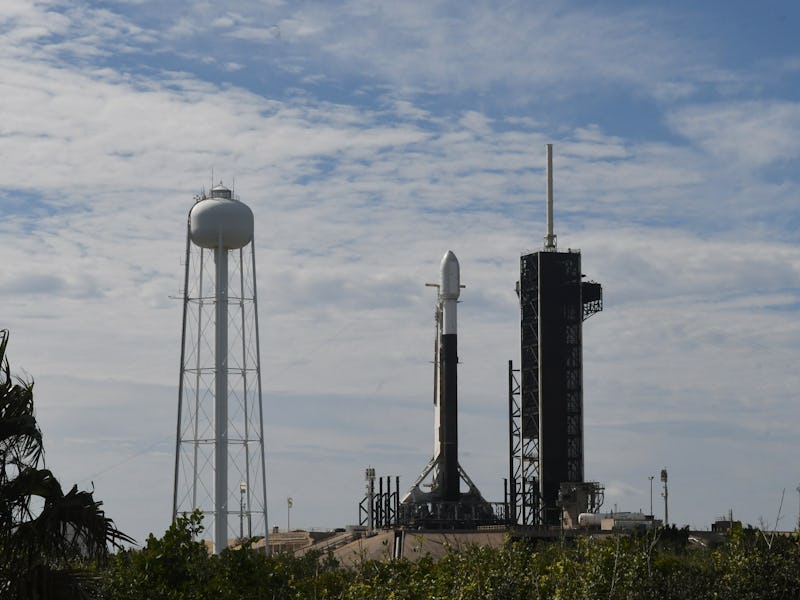SpaceX Could Launch Intuitive Machines’ Moon Lander Tonight And Finally Make History
Intuitive Machines hopes its Nova-C lander, dubbed Odysseus, will launch to the Moon tonight aboard a SpaceX Falcon 9 rocket.

Another commercial spaceflight company is about to try to land on the Moon, and this time, it’s carrying miniature art, digital archives, and NASA’s first prototype radio telescope for the Moon.
Intuitive Machines hopes its Nova-C lander, dubbed Odysseus, will launch to the Moon tonight aboard a SpaceX Falcon 9 rocket. Tonight’s launch attempt (well, technically very early Thursday morning) follows a couple of delays, first due to weather and then due to a problem with the lander’s propellant system. Here’s everything you need to know about the launch, the landing, and how to catch all the action live.
A pelican glides above the Turning Basin past a SpaceX Falcon 9 rocket that Intuitive Machines hopes will carry its Nova-C lander to the Moon.
When Will SpaceX Launch Intuitive Machines’ Moon Lander?
The IM-1 mission is scheduled to launch at 1:05 a.m. Eastern Time on February 15, which, in practical terms, means it’ll be blasting off extremely late tonight.
When Will Odysseus Land on the Moon?
The lander is scheduled to land on February 22, touching down in a small crater next door to Malapert Crater, near the Moon’s south pole. As long as SpaceX manages to launch by February 16, the lander can make it to the Moon on schedule. Otherwise, the crew will have to try for some time in March.
Why Was the Odysseus Lander Launch Delayed?
Originally, the launch was scheduled for January 12, but bad weather in Florida forced SpaceX to push back the date to February 14 (which would have been early this morning). As technicians were loading the lander’s liquid methane propellant, however, they realized the methane was at an “off-nominal” temperature and called a halt. After taking a day to tackle the methane temperature issue, SpaceX plans to try again late tonight. The problem was with the lander’s propellant system; the Falcon 9’s rocket fuel seemed to be just fine.
The Nova-C lander, with an Intuitive Machines executive for scale.
What’s On Board the New Moon Lander?
Odysseus is carrying a handful of payloads for NASA as part of the agency’s Commercial Lunar Payload Services (CLPS) program: there’s a set of various sensors and beacons to help test automatic landing technologies, along with a laser reflector to provide a very visible, very precise navigation landmark for future missions. Also aboard Odysseus is a very simple radio receiver to measure the background radio waves on the Moon; called ROLSES, it might eventually pave the way for full-scale radio telescopes on the Moon. Other instruments will monitor how space weather — the bombardment of micrometeorites, radiation, and charged particles from the Sun, and cosmic rays from deeper in space — affects the lunar surface. A set of tiny cameras will record how the lander’s exhaust plume stirs up the fine-grained regolith that covers the lunar surface.
Along with NASA’s instruments, the lander also carries a selection of historical documents and literary works stored on disks: a “Lunar Library” from the nonprofit Arch Mission Foundation (the same nonprofit organization whose illicit cargo of tardigrades spilled across the lunar surface when the Israeli Beresheet lander crashed in 2019). Odysseus is also carrying some insulating material being tested for Columbia Sportswear. There’s also a set of 125 tiny sculptures of the Moon in different phases by artist Jeff Koons (it’s also linked to an NFT project because, of course, it is).
Why Does this Mission Matter?
If it launches on time and lands successfully, IM-1 will be the first private lander on the Moon. Several other attempts, including rival Astrobotic’s recent Peregrine lander, have failed to reach the Moon or — like Beresheet — crashed into the lunar surface. IM-1 will also be the first U.S.-based lander on the Moon since Apollo 17 in 1972, and it’ll be the first successful delivery of a CLPS payload (assuming, of course, that it’s successful).
All of those distinctions would have belonged to Astrobotic’s Peregrine lander, which launched on January 8 and was scheduled to land on February 23. Peregrine carried NASA’s first CLPS payload; it just didn’t get to deliver it to the Moon as planned.
In early January, it looked like Odysseus stood a good chance of beating Peregrine to the Moon. Despite the fact that Odysseus would have launched a few days after Peregrine, the IM-1 mission planned a shorter route to the Moon and should have arrived within a week of launch; Astrobotic chose a slower but more fuel-efficient route for Peregrine. But then a wave of bad weather pummeled Florida, and SpaceX rescheduled the IM-1 launch, ceding the lead to Astrobotic and Peregrine.
When a propellant leak forced Astrobotic to cancel its plans to land Peregrine on the Moon, and bring the lander home to burn up in Earth’s atmosphere instead, Odysseus took the lead again. Keeping it depends on a successful launch tonight and a successful landing on February 22 — and if the last several months of Moon missions have proven anything, it’s that neither of those successes is guaranteed.
How to Watch the IM-1 Moon Mission Launch
NASA will start live streaming coverage of the launch about 20 minutes after midnight (Eastern Time) tonight on the NASA website. (Pro tip: If you’re staying up late to watch rocket launches anyway, you may as well tune in early at 10:00 p.m. Eastern to watch a Progress resupply ship blast off to the International Space Station.)